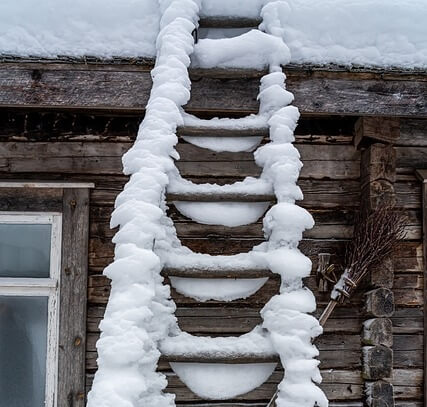
On an average day in the UK, there can be as many as two million ladders in use. That includes during winter, when people are putting up or taking down festive decorations, or sorting out emergency plumbing problems. The harsher weather of winter makes ladder safety a much higher priority than it is at any other time of year.
How to Use a Ladder Safely in Winter
If you need to use a ladder for a task that absolutely cannot wait for warmer weather, first inspect the ladder. This will confirm whether the ladder is even safe to use, let alone safe for the winter weather. If there is frost or snow on the ladder, make sure to get rid of it before use.
Be mindful of the ladder’s material too: aluminium ladders can become very, very cold at this time of year, which means that bare hands might get stuck to the rungs. This can then affect your grip and balance. Wooden ladders will expand in damp conditions, meaning the ladder might bend out of shape or even break more easily. Fibreglass is very resistant to temperature fluctuations, however, so a fibreglass ladder is an ideal choice for any winter work.
Buy Fibreglass Ladders
The type of ladder you use will also make a difference to your safety. The self-supporting A-frame of a platform or swingback ladder makes it the safest choice. By contrast, an extension ladder needs to be leant against a solid structure, and is inherently less stable for it, so you may feel less comfortable using one in winter.
You should also undertake a risk assessment of the work site. You should factor the weather into this: if it is too windy or too wet, or if it becomes too windy or too wet, do not use your ladder outdoors.
Watch out for snow and ice: neither constitutes stable ground on which to rest a ladder, so you shouldn’t treat them as such. Even with the strongest of rubber grips on the feet, your ladder could easily slip if you try to set it up on a patch of ice. As compacted as snow can become underfoot, it is not nearly strong enough to support a ladder. It’s best to clear away any snow and ice if possible before working on a ladder.
The key here is the weather: if you don’t believe the conditions are suitable for working at height, don’t get on the ladder. Otherwise, you risk hurting yourself. If you absolutely must use a ladder in winter, follow the manufacturer’s instructions and safety guidelines.
What to Wear When Using Ladders in Winter
Investing in the right clothing and PPE will definitely help you to stay safe when using a ladder in wintry conditions. Not only will you likely need gloves and other cold weather gear, but you’ll also need the right shoes. Before stepping on the ladder, make sure you’ve cleared any snow or mud out of the shoe treads. Failure to do so could affect the shoes’ grip on your ladder, potentially unbalancing you.
When using the ladder itself, you should always adhere to both the 3-point rule and the belt buckle rule. This is especially true if you’re using the ladder in winter. The 3-point rule means keeping 3 points of contact (usually a hand and both feet) on the ladder as much as possible. The belt buckle rule will stop you overbalancing and falling by ensuring you keep your belt buckle in between the side rails of the ladder.
Winter Ladder Safety Checklist
If you absolutely must use a ladder outside in winter, follow these general rules to stay as safe possible:
- Inspect the ladder before use
- Dress appropriately
- Check the weather forecast
- Inspect the work site before using it
- Stick to the 3-point and belt buckle rules
Using a ladder in winter is a matter of personal choice. If you feel that the weather conditions make it unsafe to work at height, then don’t use a ladder – and don’t let your employer force you to do so.
If you have any questions about our products, or about how to use them safely, please do not hesitate to get in touch.

 Ladders
Ladders  Step Ladders
Step Ladders  Loft Ladders
Loft Ladders  Scaffold Towers
Scaffold Towers 








